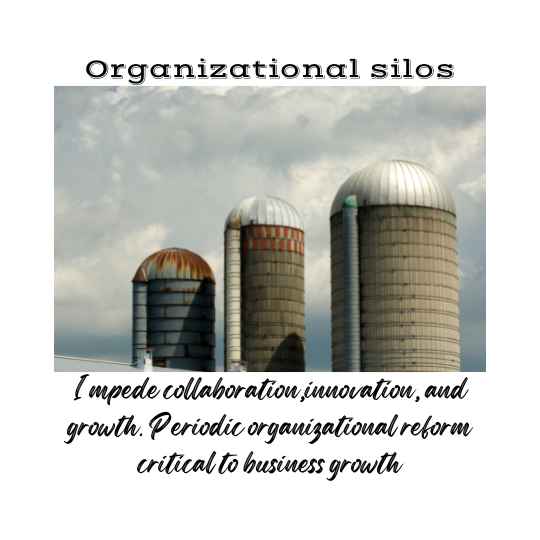Silos develop in organizations. Public and private organizations require teams to perform individual, often specialized tasks with expertise and efficiency. Organizations are therefore divided into units. Each unit has a hierarchy with a leader responsible for oversight. Hierarchies exist even in flat organizations.
Members of individual units get used to the internal ecosystem in which they operate. Collectively, they protect their turf and prevent others from creeping into their domain. Each unit is a silo, comfortable with itself and resentful of outside influence. Silos retard the cross-fertilization of ideas from the outside. They impede innovation. Management practices claim that organization development and growth require periodic breaking down of silos.
A silo, by its nature, feels the need to protect its turf. It does not want others from outside to interfere in its functioning. Silos tend to refuse to accept new ideas from outside. The absence of new ideas and cross-fertilization with other groups leads to stasis. Stasis is antithetical to growth.
Organizations require and thrive on new ideas. New ideas generate innovation. Innovation leads to growth and development. If the organization’s objective is to grow, then silos must be periodically dismantled. The dismantling process leads to disruption. Disruption leads to uncertainty which in turn leads to the diminishment of growth. In a transformation process, the disruption phase soon ends. A new vibrant unit emerges. In time this unit adjusts to a new normal.
Soon a new silo is formed as the equilibrium stage is achieved. The trick in organization reform, and transformation is to balance the need for disruption and innovation while preventing disruption from getting out of hand. The disruption phase requires to be contained.
Many of the organizational transformation needs briefly outlined above are relevant to the private sector. These principles do not fully apply to the government’s systems. Here, the requirement is the maintenance of stability and providing a rules-based order.
All organizations require specialist groups to perform business functions with expertise and efficiency. Supervision within a specialist group leads to the creation of a hierarchy. Hierarchies exist even in flat organizations. Specialist groups rapidly learn to optimize their internal organizations. As these crystallize, the group turns into a silo. A silo, by its nature, feels the need to protect its turf. It does not want others from outside to interfere in its functioning. As this happens, it refuses to accept new ideas from outside. The absence of new ideas and cross-fertilization with other groups leads to stasis. Stasis is antithetical to growth.
Organizations require and thrive on new ideas. New ideas generate innovation. Innovation leads to growth and development. If the organization’s objective is to grow, then silos must be periodically dismantled. The dismantling process leads to disruption. Disruption leads to uncertainty which in turn leads to the diminishment of growth. The disruption phase will soon end as a new unit emerges and adjusts to a new normal. Soon a new silo is formed an equilibrium stage is achieved.
The trick in organization reform and transformation is to balance the need for disruption and innovation while preventing disruption from growing out of hand. The disruption phase requires to be contained. The requirement for breaking down silos, the need for renewal, and the cost of disruption have to be calculated by the leadership in the organization. Based on this analysis, the call is taken on the extent to which an organization’s psyche will accept reform.
About the author:
I am a content writer specializing in innovation and business transformation.
